-
Membership
Membership
Anyone with an interest in the history of the built environment is welcome to join the Society of Architectural Historians -
Conferences
Conferences
SAH Annual International Conferences bring members together for scholarly exchange and networking -
Publications
Publications
Through print and digital publications, SAH documents the history of the built environment and disseminates scholarshipLatest Issue:

-
Programs
Programs
SAH promotes meaningful engagement with the history of the built environment through its programsMember Programs
-
Jobs & Opportunities
Jobs & Opportunities
SAH provides resources, fellowships, and grants to help further your career and professional life -
Support
Support
We invite you to support the educational mission of SAH by making a gift, becoming a member, or volunteering -
About
About
SAH promotes the study, interpretation, and conservation of the built environment worldwide for the benefit of all
Conversations around Temples: Integrating Myth in a Study of a Ritual Landscape in Eastern India
Sara Varanese is the 2022 recipient of the SAH Dissertation Research Fellowship. She is a PhD candidate in the Department of Art History at Rutgers University. All figures author’s own.
I am in Bhubaneswar, the capital of Odisha in Eastern India. Since I arrived, I am spending days and days at each of the many temples of this medieval city. I get to know the material slowly by going through each detail, taking notes, describing the iconography and location of each image. I measure each of the empty niches where icons are missing, maybe carried off to some museum, maybe lost to the antiquities trade. I take notes by hand, I sketch the layouts, I draw the base moldings.
In this process of just being with the temples, I encounter another kind of source. Temple goers, curious to see me there, stop and ask questions. Sometimes they tell me the reason why they are at the temple. Sometimes they explain the stories behind the temples and the deities. The Brahmins ask what I am doing, why I am there every day. I show them my notebook, the sketches. I explain that I am a researcher. And in these encounters, I can also start asking questions.
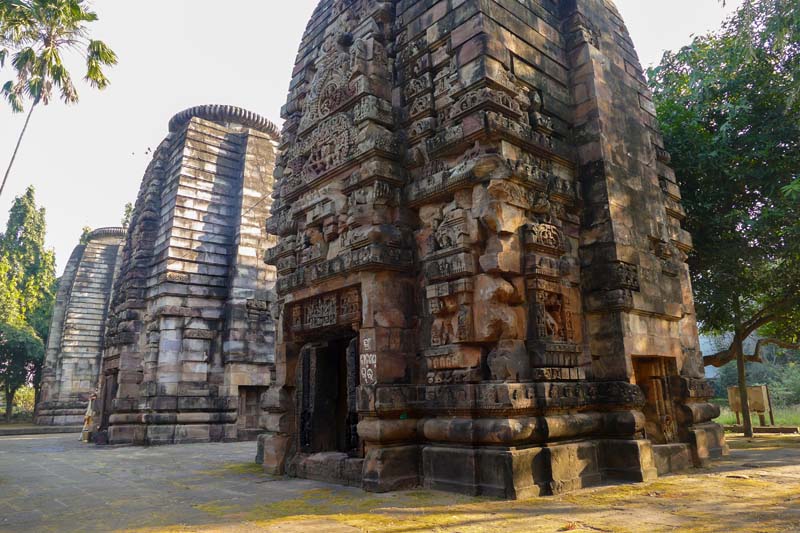
Figure 1: The Shatrughneswara, Bharateswara and Lakshmaneswara temples are all located in the same enclosure and were all built at the same time, at the end of the sixth century CE.
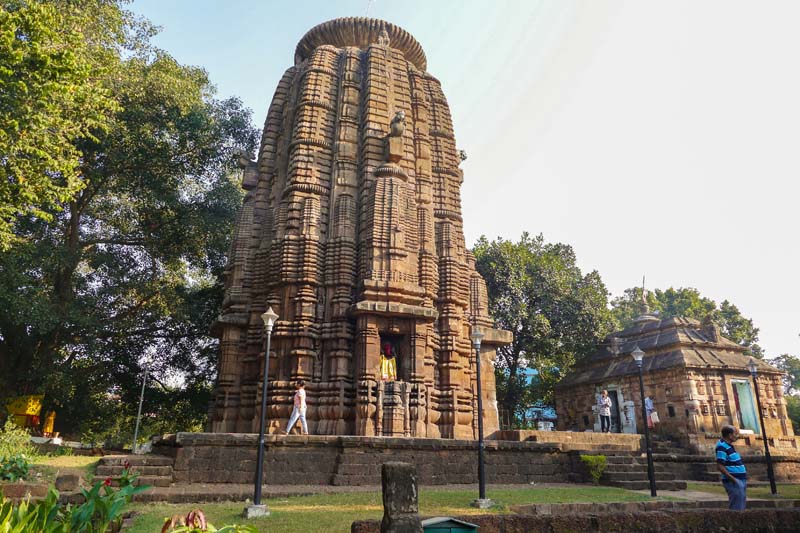
Figure 2: The Rameswara temple dates from the twelfth century, but is built on top of remains of a preexisting temple.
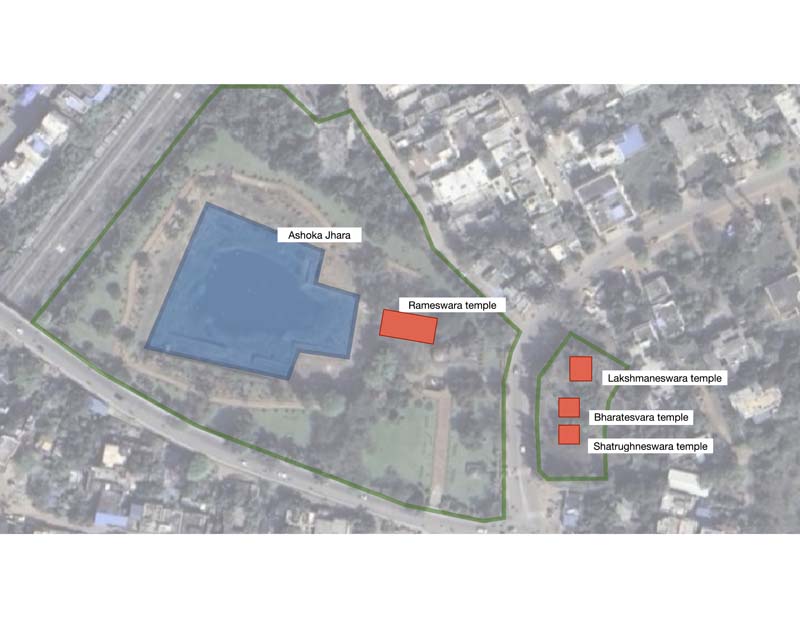
Figure 3: The site of the Rameswara temple, with the three temples dedicated to his brothers located just across the street. Behind the Rameswara is a large water reservoir, the Ashoka Jhara.
I am sitting in front of three of Bhubaneswar’s oldest temples, dating from the sixth century (Figure 1). A man has been performing a ritual for his son’s wedding. When he understands that I am working on the medieval city, he volunteers the story of the temples. The heroes of the Ramayana, one of the most known epic tales of India, came here to repay their karmic debt after slaying their enemy, Ravana, who was a demon but also a Brahmin.1 "This is where Ram and his brothers sat and did penance," I am told. The three temples are named after Lakshmana, Bharata, and Shatrughna, Ram’s three brothers. A bigger temple just in front of them and across the street is named Rameswara, after Ram himself (Figures 2 and 3). In the oral history of Bhubaneswar, these temples are the petrification of a mythological event.
The next day I am at the temples again, and a Brahmin gives me the second half of the story. To reward the brothers for their penance, the god Shiva descended and showed himself to them, thus establishing himself in Bhubaneswar. This event also corresponds to a physical site in the city. The main temple in Bhubaneswar, the Lingaraj temple, is built around a svayambhu lingam, a natural rock formation that is believed to be a manifestation of Shiva (Figure 4).2
The sequence of events transmitted by communal memory is confirmed by the landscape. Oral history establishes a series of events in time, and connects them to the site of the Rameswara, where the three brothers sit, then to the site of the Lingaraja, where Shiva appears (Figure 5). The dating of the temples themselves, in their earliest iteration, places all of them at the very beginning of temple-building activity in Bhubaneswar, around the sixth and seventh centuries.3 They are all equally ancient, part of the earliest ritual foundations of the city. However, another element of the landscape suggests a greater antiquity for the Rameswara site. Just behind the temple, a water reservoir named Ashoka Jhara is the find site of a capital dating from the third century BCE.4 The name of the Ashoka Jhara and the archaeological findings here indicate that the site does in fact pre-date the Lingaraja temple.5
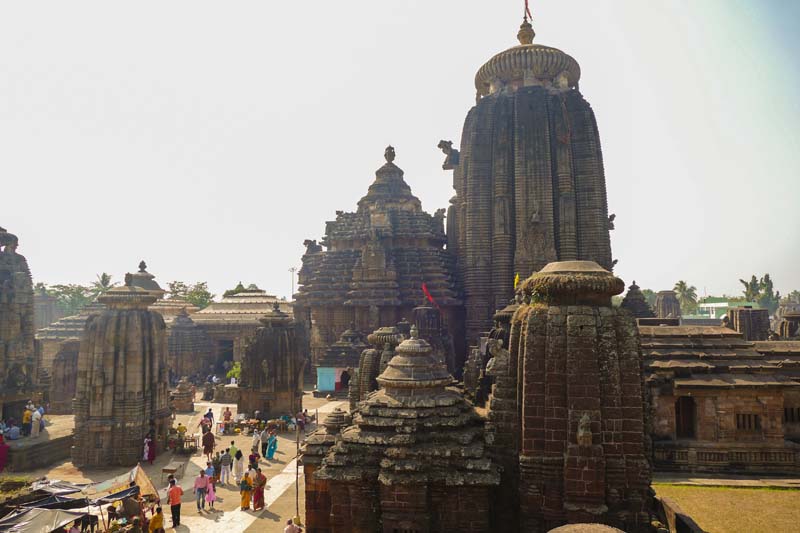
Figure 4: The Lingaraja temple dates from the eleventh century, but its enclosure contains sculptures and fragments dating from the seventh century. Historical texts also suggest the existence of a structure here at least from the sixth to seventh century.
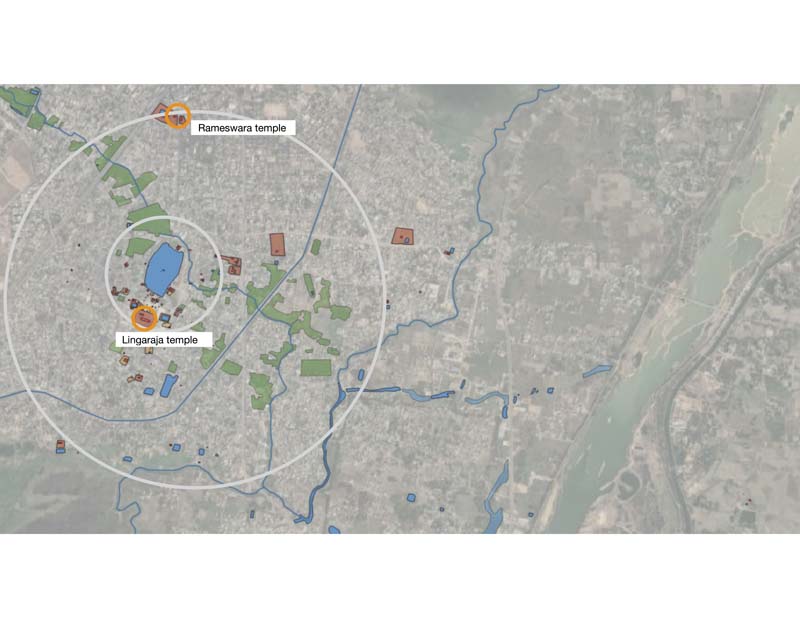
Figure 5: The sites of the Rameswara and Lingaraja temples in the context of Bhubaneswar. The grey outline marks the approximate extent and distribution of the medieval material in Bhubaneswar. A denser urban core is surrounded by satellite clusters around a mile away from the central area. One of these clusters is the Rameswara group.
As I spend time in the field, I understand more about the role of oral history in my research. I started working on the landscape of Bhubaneswar from maps and satellite imagery, referencing secondary bibliography and scholars’ dating of its many temples and archaeological sites. I mapped the temples in a digital software and connected each element of the landscape to a database, literally a collection of "data," as I tried to understand the history of this city and reconstruct a chronology of its urbanization. Now that I am in the field, I realize that my analysis of the physical landscape, of materiality and spatiality, is not enough to describe its ritual spaces. When grounded in the lived experience of the temples, my project takes on additional layers, which must somehow coexist with the "data," even while confusing it sometimes. I am still learning to navigate these forms of tradition and knowledge that have been passed on from person to person—sometimes eventually written—in what is known as "twilight language," sandhya, where information is kept beneath the wavering surface of narration and symbol. Oral history and the language or myth are not "data," yet they are a fundamental part of the experience of the city and essential to its understanding. At least for the area around the Rameswara temple, oral history and archaeological material coincide in identifying this as one of the oldest sites in the settlement’s history, predating the construction of the first temples by almost a millennia.
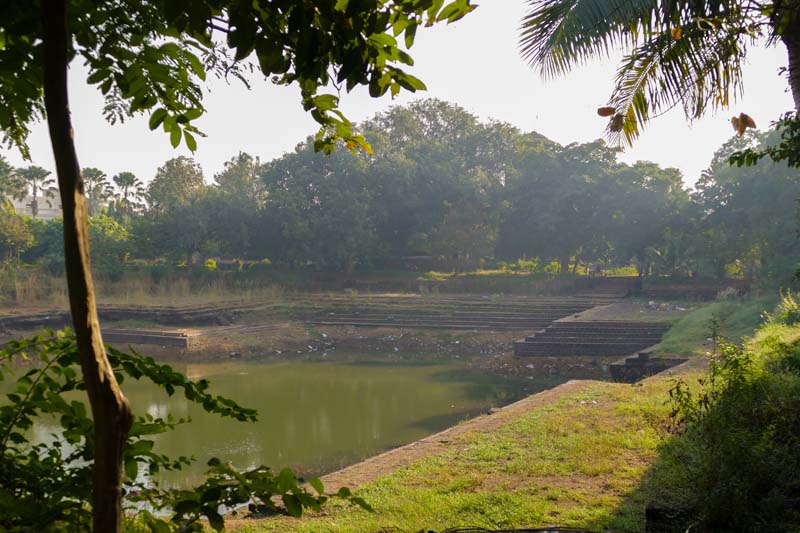
Figure 6: View of the water reservoir of the Ashoka Jhara, slightly depleted during the dry season. The spire of the Rameswara temple is just visible behind the trees in the background.
1 The Sanskrit epic of the Ramayana was composed between the seventh century BCE and the fourth century CE. In the story, the hero Ram and his three brothers slay the demon Ravana. However, Ravana is a Brahmin, and his killing is considered one of the most terrible sins that can be committed. To recover from their karmic debt, Ram and his brothers turn to the god Shiva, who orders them to go to Bhubaneswar to worship him in order to atone for their act.
2 A svayambhu lingam is an especially potent natural occurrence that automatically establishes a sacred landscape, as it indicates a place that was chosen by the deity itself to establish their presence in the landscape. Svayambhu literally means "self-created" or "self-manifested." A lingam is an aniconic representation of the deity Shiva, considered to be more powerful than his anthropomorphic icons. It has a phallic shape, symbolizing creation and fertility.
3 The Rameshwara dates from the early twelfth century, but is built on seventh-century remains of an earlier stucture, possibly contemporary to the three smaller temples of the Shatrughneshwara, Bharateshwara, and Lakshmaneshwara, all dating from the sixth century themselves. The extant Lingaraja temple dates from the late eleventh century, but the earliest date reported by historical texts for the existence of a shrine at this site is the seventh century. See Thomas E. Donaldson, Hindu Temple Art of Orissa, vol 1, Studies in South Asian Culture, v. 12 (Leiden: New York : E.J. Brill, 1985); Chandra Krishna Panigrahi, Archaeological Remains at Bhubaneswar (Orient Longman, 1961); Charles Louis Fabri, History of the Art of Orissa (Bombay: Orient Longman, 1974).
4 The site of Bhubaneswar in general has a long archaeological history that is connected to the Mauryan period (c. fourth to second century BCE) and to the emperor Ashoka, whose capital, Toshali, has been identified by some scholars in a ruined fortification just southeast of the medieval city. See Chandra Krishna Panigrahi, Archaeological Remains at Bhubaneswar (Orient Longman, 1961), 178–180.
5 Scholars consider contemporary ritual performance in Bhubaneswar as additional proof of the preexistence of the Rameswara. "The sanctity of this site is still celebrated today by a festive visit once a year on the day of Ashokastami in the month of Chaitra (March–April) by the movable images of the lord Tribhuvaneswara (Lingaraja) and his family members, a ritual suggesting the deity of a later shrine paying homage to the deity of an earlier shrine." Chandra Krishna Panigrahi, Archaeological Remains at Bhubaneswar (Orient Longman, 1961), 190. See also Thomas E. Donaldson, Hindu Temple Art of Orissa, vol 1, Studies in South Asian Culture, v. 12 (Leiden: New York : E.J. Brill, 1985), 31.


Leave a commentOrder by
Newest on top Oldest on top